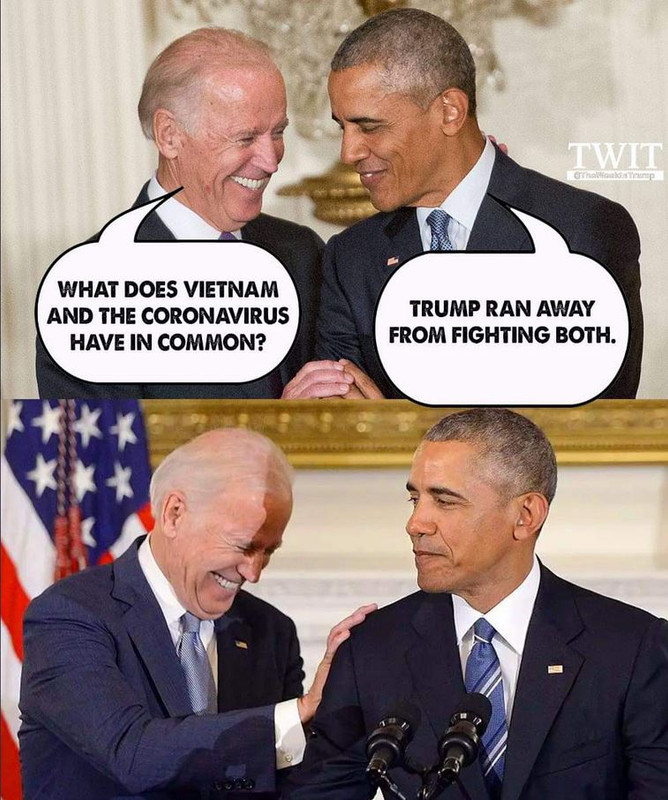The Wall Street Journal article that the Waco Kid referenced came out a few days ago. They published another today that's even more interesting. I've posted previously on the mine referenced in the following, and that people infected in the mine could have been the source of COVID 19. That is, they may have been affected by a coronavirus that mutated and became COVID 19. Well, the WSJ article shows the Wuhan lab was studying the virus that infected the miners.
Here's an excerpt,
Hidden mine
Chinese authorities have obstructed independent efforts to investigate the mine, setting up a checkpoint nearby where unidentified men stopped several foreign journalists in recent weeks, on one occasion warning there were wild elephants ahead.
A Journal reporter reached the mine by mountain bike but was later detained and questioned for about five hours by police, who deleted a cellphone photograph of the mine. Villagers told the reporter that local officials had warned them not to discuss the mine with outsiders.
There was no sign of nearby villages being evacuated or any recent research activity at the mine. It was so overgrown that its entrance appeared to be inaccessible.
A growing number of virologists, biologists and other leading scientists are calling for a closer examination of the lab hypothesis.
Asked in a May 11 Senate hearing whether he thought the Covid-19 virus might have escaped from a Wuhan lab, Anthony Fauci, President Biden’s chief medical adviser, said, “That possibility certainly exists, and I am totally in favor of a full investigation of whether that could have happened.” Dr. Fauci is director of the National Institute of Allergy and Infectious Diseases, or NIAID, which has funded coronavirus research conducted with the WIV. He has said previously that the Covid-19 virus mostly likely evolved and jumped to humans in nature.
Last year, 27 scientists signed an open letter condemning “conspiracy theories” suggesting that Covid-19 didn’t have a natural origin. Now, three of them since contacted by the Journal say that on further reflection a laboratory accident is plausible enough to merit consideration. Others continue to deem it too unlikely to justify investigation.
“I’m convinced that what happened is that the virus was brought to a lab, they started to work with it…and some sloppy individual brought it out,” said Bernard Roizman, a University of Chicago virologist and one of the signers. “They can’t admit they did something so stupid.”
A small group of academics and internet sleuths have been working together for months, using social media to collate and publish evidence of the WIV’s activities, especially in relation to the mine. They have called in three open letters since March for a fuller probe of the lab hypothesis.
On May 13, a group of 18 scientists from universities including Harvard, Stanford and Yale published an open letter in the academic journal Science calling for serious consideration of the lab hypothesis and urging research laboratories to open their records.
Among the signatories to the Science letter was Ralph Baric, a microbiologist at the University of North Carolina who worked with the WIV on a study, including on a study to create an artificial coronavirus that infected human cells in the lab.
In an email, he said SARS-CoV-2’s genetic structure suggests it originated in wildlife and evolved naturally to infect humans, and that he believes that is the most likely scenario, but “more investigation and transparency are necessary to define the origin of the pandemic.”
“A rigorous investigation would have reviewed the biosafety level under which bat coronavirus research was conducted at WIV,” he said. “It would have included detailed information on the training procedures with records, the safety procedures with records and strategies that were in place to prevent inadvertent or accidental escape.”
The shift among leading scientists is partly due to conflicting statements from Chinese researchers. Some scientists say another factor has been a toning down of U.S. government rhetoric on the subject in recent months.
The WHO-led team that visited Wuhan early this year concluded in a joint report with Chinese experts in March that Covid-19 most likely moved from bats to humans, via another mammal, and ranked a laboratory leak at the bottom of its list.
The team, which spent three hours at the institute, had little to go on beyond assurances from the institute’s own staff, team members say. On the same day the report was released, Dr. Tedros said the team hadn’t adequately explored a potential lab origin.
The U.S., European Union and several other governments responded to the report by appealing for a more robust, transparent investigation into the pandemic’s origins, without calling publicly for a full inquiry into the lab hypothesis.
Some scientists question why the WHO-led team, which has sought to investigate clues to the pandemic’s origins in other countries such as Italy, hasn’t been able to arrange antibody tests and surveys of people and animals around the overgrown mine that held the virus most closely related to SARS-CoV-2.
The team has recommended such research, but the “timeline is still, still not clear,” said Peter Ben Embarek, the food-safety scientist who led the team. “Ideally, starting soon.”
Mysterious virus
The most detailed account of the miners’ illness comes in a master’s thesis by Li Xu from the No. 1 School of Clinical Medicine at Kunming Medical University in southwest China. He didn’t respond to requests for comment.
His thesis, supervised by the hospital’s emergency chief at the time, describes how a 42-year-old man surnamed Lü was admitted there on April 25, 2012.
Mr. Lü had been clearing bat guano at the mine, in China’s Mojiang region, since April 2 and had suffered from a fever and cough for two weeks. For the previous three days, he had trouble breathing and had begun coughing up rust-color mucus spotted with blood.
A CT scan revealed severe pneumonia, with the same lung markings now seen in many Covid-19 patients. Still, blood and other tests couldn’t pinpoint the cause.
Over the next week, five others working at the Mojiang mine, ages 30 to 63, were admitted to the same hospital. All had similar symptoms.
Doctors consulted experts in respiratory disease, including Zhong Nanshan, who had led the fight against China’s 2002 and 2003 outbreak of severe acute respiratory syndrome, or SARS.
Dr. Zhong diagnosed pneumonia, most likely caused by a virus, and recommended testing for SARS antibodies and trying to identify the type of bats in the mine. He didn’t respond to a request for comment.
Another thesis, written by a Ph.D. candidate supervised by George Gao, the current head of the Chinese Center for Disease Control and Prevention, or China CDC, said four of the miners tested positive for SARS antibodies.
The hospital contacted experts from several other institutions, including the WIV. None could identify what caused the miners’ illness.
By mid-August 2012, three of them were dead. The suspicion was that it was a bat-borne SARS-like coronavirus, according to Mr. Li’s thesis. Chinese scientists, who were still searching for the origins of SARS, knew that bat caves in the area were a potential source, and they had been collecting samples from them.
Over the next year or so, WIV scientists entered the Mojiang mine and took fecal samples from 276 bats, identifying six different species, according to a research paper they published later.
They extracted genetic material from the samples and sequenced fragments. Half of the samples tested positive for coronaviruses, including an unidentified strain of a SARS-like one, according to the scientists. They called the virus RaBtCoV/4991.
Critically, all six bat species showed evidence of coronavirus co-infection, the researchers found. In other words, the virus could easily exchange genetic material with similar ones to create a new coronavirus—an environment ripe for the creation of new viruses that could potentially infect humans.
That research was led by Shi Zhengli, the WIV’s leading bat coronavirus expert. When the results were published in 2016 in the journal Virologica Sinica, few scientists paid attention to RaBtCoV/4991. It didn’t appear to be closely related to SARS. It came from an abandoned mineshaft, said the paper, which made no mention of the miners who fell sick there.
Only after the Covid-19 pandemic began did it become more significant. In February 2020, Dr. Shi and her colleagues published a paper in the scientific journal, Nature, revealing the existence of a virus called RaTG13. Sequencing had revealed it was 96.2% similar to SARS-CoV-2 genetically, making it the closest known relative to the pandemic virus.
They said it was found in a bat in Yunnan, the Chinese province that includes the Mojiang region mine, but didn’t say when or where.
That revelation was considered a breakthrough in the search for Covid-19’s source, strongly indicating that it originated in bats.
Striking similarities
In the following weeks, however, some scientists outside China noticed striking similarities in the sampling dates and partial genetic sequences of the virus called RaTG13 and the one called RaBtCoV/4991, which Dr. Shi’s team had found in the Mojiang mine.
After repeated requests by scientists to clarify the issue, Dr. Shi said that the two viruses were one and the same. She updated her paper in Nature in November to reflect that and include details about the sick miners.
The virus had been renamed to reflect the bat species, its location, and the sampling year, she said.
She also revealed that the WIV retested samples from the miners and established that they weren’t infected with SARS-CoV-2. And she disclosed that her team subsequently had found eight other SARS-type coronaviruses in the mine.
On Friday, after repeated requests from scientists to share the genetic sequences of the viruses, Dr. Shi and colleagues released a scientific paper on a preprint server, meaning that it has yet to be peer-reviewed. The paper said the eight were almost identical to each other and only 77.6% similar to SARS-CoV-2, although one part of their genetic code was a 97.2% match. “Albeit there is a speculation claiming the possible leaking of RaTG13 from lab that caused SARS-CoV-2, the experiment evidence cannot support it,” the paper said.
Many scientists question why the WIV didn’t announce the existence of those viruses earlier, as well as their connection to the mine, and why they waited so long to allow scientists to examine their sequences. Such information about the types of coronaviruses that were circulating is critical in the search for the pandemic’s origins, they say.
Some have noted that Dr. Shi has repeatedly asserted that the Mojiang miners had a suspected fungal infection, not a virus, contradicting research papers at the time and Dr. Shi’s update in Nature, which said the miners were thought to have a virus.
Dr. Shi didn’t respond to requests for comment.
Many scientists are eager to examine the WIV’s once publicly available database of some 22,000 samples and virus sequences, including 15,000 from bats. The database was taken offline in September 2019. Dr. Shi told the WHO-led team in February that the database was taken offline after being subjected to more than 3,000 cyberattacks.
The WHO-led team that visited didn’t ask to view the data, according to Peter Daszak, president of EcoHealth Alliance, a New York-based nonprofit, who was on the team. The database included information the WIV had gathered through work with EcoHealth Alliance, which was funded by the NIAID and collaborated with the WIV to study coronaviruses in bats. Dr. Daszak said earlier this year that because of his organization’s work with the WIV, “we basically know” what viruses were in the database, and none was closer to SARS-CoV-2 than RaTG13.
Moreover, RaTG13 was genetically very distinct from SARS-CoV-2 and had never been successfully cultured in the lab, he and other scientists on the WHO-led team said. “Of course we discussed it,” said Dr. Ben Embarek, the WHO team leader. “From what we know, only a sequence exists. No virus. They never succeeded to culture a virus out of the bat feces sample.”
If the WIV had only the genetic sequence, it wouldn’t have had an infectious RaTg13 virus that could have escaped from the lab. Having only the genetic sequence also raises questions about the extent to which it could have been used as the basis for experiments to create man-made viruses.
Other scientists, however, say that cannot be independently verified without viewing the WIV’s lab logs, sample records and viral database and that research papers show its employees were combining some bat coronaviruses they had cultured with genetic material from others.
Some are uncomfortable with Dr. Daszak’s role in the WHO-led team, given his close relationship with the WIV and his stated rejection of the lab hypothesis since early last year. Dr. Daszak has said he provided a conflict of interest statement to the WHO when he applied to be on the team. The WHO has said it determined his work didn’t pose a conflict.
Lab experiments
One area of controversy is the experiments the WIV was doing to construct new viruses by combining elements of existing bat coronaviruses to determine whether they could become more infectious to humans.
Such experiments—sometimes described as “gain-of-function” research— have long been controversial among scientists. Supporters say they are the best way to identify potential sources of future pandemics and to develop vaccines. Critics say the risk of harmful, genetically enhanced viruses leaking from a lab is too great. Scientists debate what types of experiments constitute gain-of-function research.
The U.S. National Institutes of Health paused funding gain-of-function research in 2014, and in 2017 introduced a system requiring an expert-panel review of any grant proposals involving gain-of-function experiments. China’s restrictions were looser.
Some scientists say work described by Dr. Shi fits a broad definition of gain-of-function research. There are wide differences of opinion about where the boundaries are drawn.
Dr. Shi has publicly described doing experiments, including in 2018 and 2019, to see if various bat coronaviruses could use a certain spike protein on their surfaces to bind to an enzyme in human cells known as ACE2. That is how both the SARS virus and SARS-CoV-2 infect humans.
Those experiments involved combining one bat coronavirus with the spike protein of another and then infecting mice genetically engineered to contain human ACE2, Dr. Shi told the WHO-led team in February, according to its report.
Dr. Daszak described similar work, conducted by Dr. Baric of UNC, in a podcast shortly before the pandemic began, saying the aim was to create a vaccine for SARS. EcoHealth Alliance described such experiments as one of the aims of its NIAID bat coronavirus research grant awarded in 2019. But the nonprofit, in accordance with the NIH moratorium, “has not participated in nor funded gain-of-function research” and no “in vivo” research was conducted on this grant, an EcoHealth Alliance spokesman said. The NIH suspended the grant in 2020.
“If the world wants to shut down work that was not gain-of-function because of a conspiracy theory, that’s a huge mistake,” Dr. Daszak said earlier this year. ”This virus, it’s extremely unlikely that it came from a lab. If we focus on the lab issue and ignore what really happened, we do so at our ultimate peril.”
One question now dividing the scientific community is whether such experiments could have created SARS-CoV-2, either accidentally or as part of a deliberate effort to see which viruses could evolve into ones dangerous to humans.
Many prominent scientists say that would be impossible with RaTG13, and that SARS-CoV-2 could only have been created out of a virus that was genetically closer to it. While the WIV has said RaTG13 is the closest relative it had to the pandemic virus, scientists calling for a lab investigation want access to the lab’s records to verify that.
Gain-of-function experiments would leave clear genetic signatures in sequences of the virus showing that part of it was inserted in a laboratory, many molecular biologists say. Other scientists say more modern techniques can leave no trace.
Ian Lipkin, an infectious-disease specialist at Columbia University who has worked closely with Chinese research partners, was among five scientists who last year co-wrote a paper dismissing the idea that the virus was manipulated in a lab. Now he says he is concerned that the WIV was doing experiments on coronaviruses in laboratories at a lower biosafety level than required in the U.S.
Dr. Shi told the WHO-led team that there had been no leaks and none of her team had tested positive for Covid-19.
Several of Dr. Shi’s foreign research partners have said they found her laboratories and work practices to be safe. “Shi Zhengli runs a tight ship,” said Maureen Miller, an infectious disease epidemiologist at Columbia University. “They are sharp, smart people. She was working to prevent exactly this kind of pandemic. She knows the seriousness of working with coronaviruses.”
https://www.wsj.com/articles/wuhan-l...covid-pandemic


